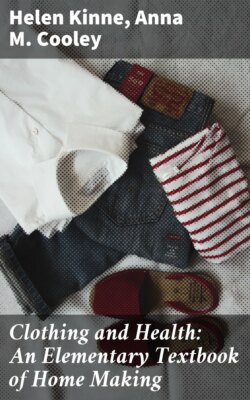Читать книгу Clothing and Health: An Elementary Textbook of Home Making - Helen Kinne - Страница 13
На сайте Литреса книга снята с продажи.
Lesson 6
ОглавлениеTable of Contents
PLANNING TO MAKE AN APRON
The girls of Pleasant Valley school decided to make caps and aprons. They help every day with the preparation of the school lunch. The aprons will keep their dresses clean, so the girls will look neat and tidy. The aprons can also be used at home. Let us too learn how to cut them carefully.
The samples which Marjorie Allen brought from the store have been examined and studied carefully. The girls know now the difference in appearance between percales, calicos, ginghams, chambrays, and also how much they cost. Most of the girls have decided to make pink and white, or blue and white, checked aprons of gingham. It costs 12½ cents a yard; and the girls require from two and one-half to three yards, according to size. They are to make their own pattern for the aprons, as they are so simple. When they make the petticoats for the Fresh Air children, they will learn to use a commercial pattern.
Fig. 23.—The plan for the yoke of the apron.
Cutting the skirt part. Each girl will need two lengths for the skirt part of the apron, measuring from the armhole at chest, to the desired length. No pattern is necessary for this skirt part. On each length allow four inches extra for hem. Tear one length, lengthwise; be careful not to tear it crosswise of the material. The two pieces torn down are to be placed one on each side of the whole width, with selvedges together.
Planning the pattern for the yoke. Now the yoke pattern is to be made. Miss James helped the Pleasant Valley girls with the patterns. You will need a good-sized piece of paper, pencil, and a tapeline. Measure the width of chest from side to side, just at the armhole in front. Look at diagram (Fig. 23); this measure is the bottom of the yoke. Draw a line the length of chest measure across the bottom of your paper. Measure up six inches, and draw a line at right angles to each end of the chest line. This is to find the shoulder. Draw a dotted line three inches at right angles to this, as shown in the diagram. Then draw a line three inches to form a third side of the square. Do this for the other shoulder and connect the two lines with a line parallel to the chest line. You will have a yoke three inches wide in front. The shoulder lines are too straight; so draw slanting lines just a little towards the outside or armhole side, taking off one-half inch on shoulder edge. This is the only pattern needed; for the back pattern is exactly the same, but is divided in half and cut straight through the center for the opening in back.
Fig. 24.—Four of the Pleasant Valley girls wearing their finished aprons.
Cutting the yoke. Lay the pattern on the cloth so that the width of chest line is on the filling threads of the cloth. Four pieces will be needed. Can you double your cloth and cut two at once? The yoke is made double of two thicknesses; that is why we must cut two pieces for the back and two for the front. Cut the two back portions through the center back, on the thread of material. Now our aprons are all cut. Carefully roll up the pieces and material left, for you will need them if you make the caps.
Basting the skirt part. Let us make the skirt of the apron first. Pin the widths together, selvedge to selvedge, to form seams. You all know what the selvedge is. Look in the dictionary. How is it made so firm? The whole width is for the center front; the half width for each side. Pin together and baste one-fourth inch seams, to within 8 or 9 inches of each length; this will be left open under each arm. Baste also one-fourth inch hems at the outside edges of the side lengths which are raveling. Turn the hems to the same side as the seams, the wrong side. Now all the basting is done, and next time we shall be ready for a new stitch. The picture (Fig. 24) shows some of the Pleasant Valley girls wearing their aprons. Can you guess which is Mollie Stark or Barbara Oakes?
EXERCISES AND PROBLEMS
1. Look up these words in the dictionary: selvedge, warp, woof, pattern.
2. Name other materials, besides gingham, suitable for work aprons.
